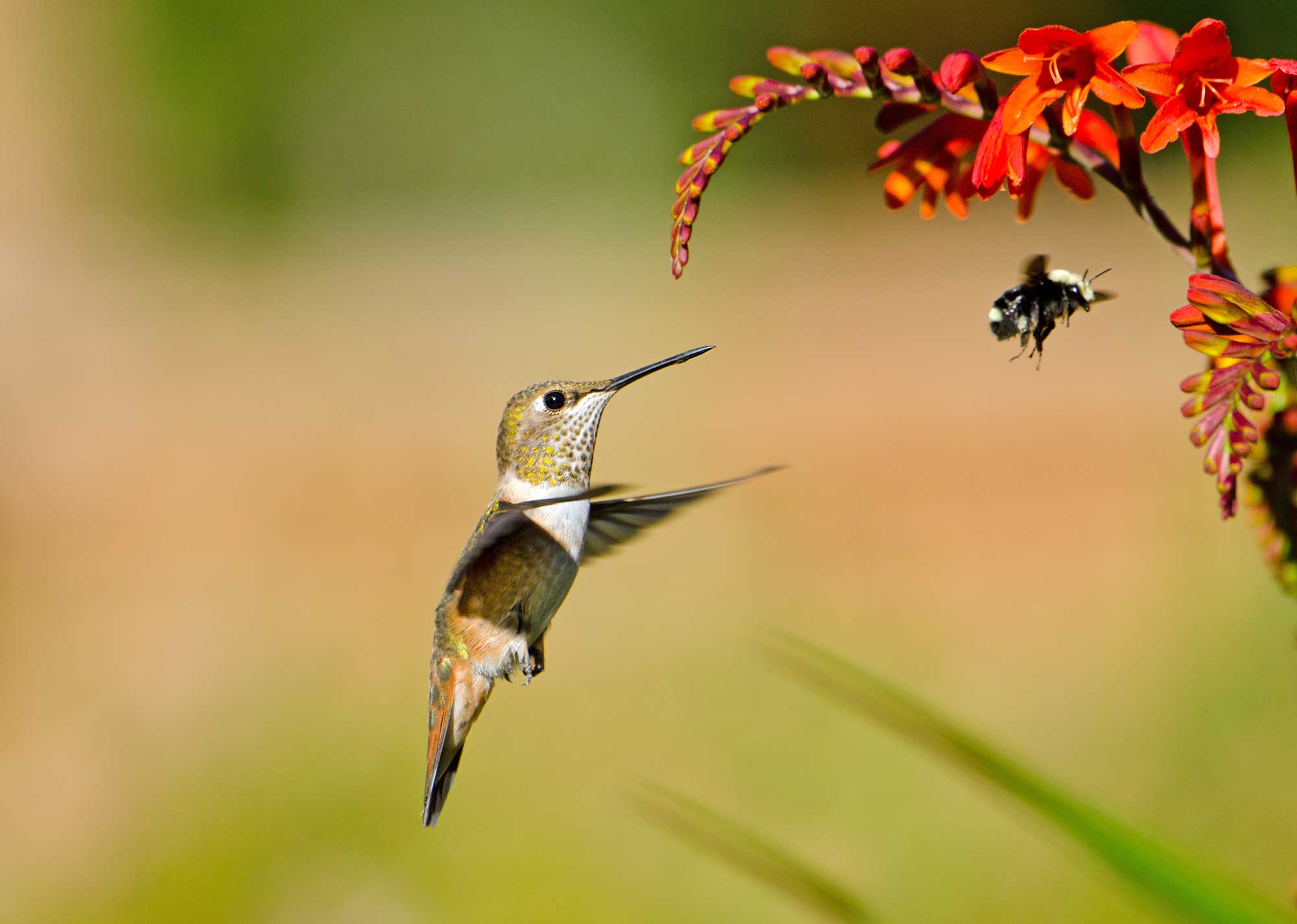Pollination keeps our food crops productive, which is why there is a growing awareness of the value that different pollinators quite literally bring to the table. However, even though several species are responsible for pollination, hummingbirds and bees play various roles that are necessary for a healthy and complete pollination process. One of the most notable differences between these two beloved pollinators is that hummingbirds do not collect pollen with hairy legs.
Beekeepers enjoy observing the pollen collection loads their bees bring back to the hive. Bees collect from flowers and other sources through an almost magnetic process using the hair on their bodies. It seems as if bees have been created explicitly for this purpose. Hummingbirds and bees are without a basket to collect, but hummingbirds only exist in the western hemisphere near the equator belt. Hummingbirds are not as common as bees, but they comprise more than 364 species, with 15 of these living permanently in the United States.
Size Doesn’t Matter
Hummingbirds are known for their tiny size, but some are as small as a bee, and others can be up to four nickels in length. Even large hummingbirds are comparatively small in nature. Hummingbirds have a following, with feeders a frequently purchased item to attract these darling hummers and draw them in close enough to observe. Their short and sleek bodies glimmer, and they flutter things wings at impressive speeds that seem to keep them stationary, although they are in constant motion. Hummingbirds can also fly backwards, which bees also do when leaving their hives to create landmarks to follow on their return.
Comparing Consumption
When comparing hummingbirds to bees in captivity, hummingbirds consume a significant amount of nectar, which is why many who have feeders continually refill the source with sugary water. Hummingbirds use their long beaks to penetrate flowers and loosen pollen from the anthers. The pollen sticks to the beak and face of hummingbirds. The wings, moving at their speed, create turbulence in the air, sending grains of pollen into the air. Pollen lands in different spots and on another flowering source, creating pollination. The feathers of the hummingbird are barbed, which collect grains of pollen and carry them from flower to flower as they drift between sources like pixies.
When bees collect pollen, they are right at the source of the pollen. Their little hair bodies effortlessly collect pollen.
The Heavy Lifting
Hummingbirds may visit more than 2000 flowers every day, whereas the honeybee typically stops closer to 1500 times a day at different sources. The type of flower density, weather, and how far they have to go are all factors for bees, but when it comes to the heavy lifting, hummingbirds individually are doing more. However, the size of bee colonies can equal 20,00 bees, which, if they all forage, collectively do more pollination than hummingbirds.
Arguably, either pollinator is doing more of the heavy lifting, whether in terms of numbers or size. However, both are essential to the process!
Sharing is Caring
Pollinators collectively do their jobs, keeping crops fruitful and contributing to the spread of pollen. Almost as if by divine design, hummingbirds and bees pollinate without fierce competition. Although hummingbirds and bees both enjoy anise hyssop, geraniums, and zinnias. Hummingbirds run solo on long, narrow tubes, conducive to the hummingbird’s long beak. Hummingbirds will spend more time at foxgloves and daylilies, which means hummingbirds and bees don’t overlap in all pollination efforts. Although they can share some sources, there are things hummingbirds can use for pollen that bees simply can’t

Get help with your beehive or bee swarm removal! Call Today 760-224-3040 Or 951-265-8292!
Hummingbird Feeders
Many times, people get a hummingbird feeder to get close enough to these beautiful creatures to observe them and maybe get a picture. However, bees will also come to feeders and slurp up the yummy syrup. Hummingbirds may not forage as much when feeders are present because they only need nectar, not pollen. Bees, on the other hand, need both, so even if there are hummingbird feeders with red sugary syrup in them, they will continue to forage.
If a hummingbird feeder is an unwanted attraction for bee activity, the feeder can always be moved away from high-traffic areas. Suppose a beehive ends up in a spot that poses a concern for people and pets. In that case, it is crucial to hire only reputable bee removal companies that use humane methods and prioritize re-homing displaced bees. Local beekeepers work together in any bee crisis, and it is never acceptable to try to kill a beehive or bees. Anything toxic to bees will be transferred to plants and flowers, potentially harming other pollinators in the area, including the beloved hummingbirds.
Contact D-Tek Live Bee Removal today for a free inspection and the best live bee removal and repair service in the area. We are standing by at 760-224-3040 – call us today!
